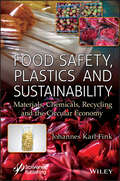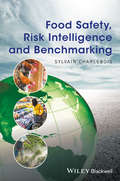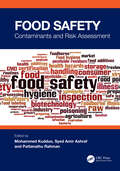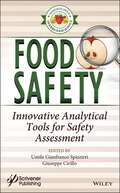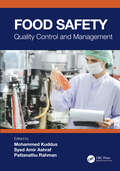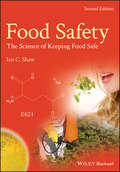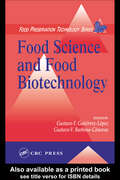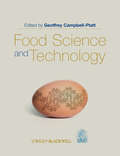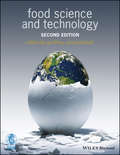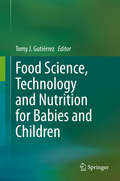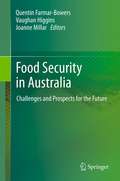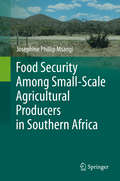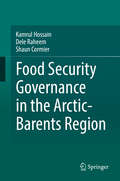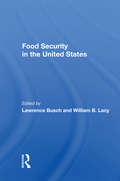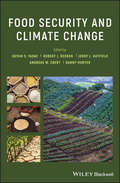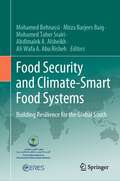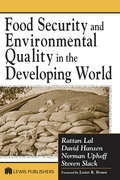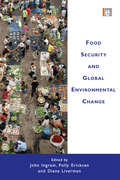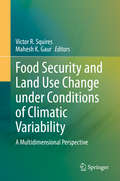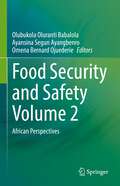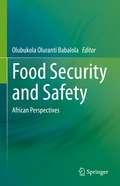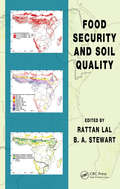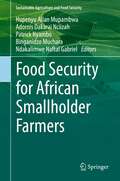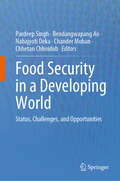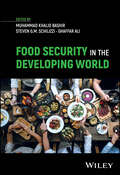- Table View
- List View
Food Safety, Plastics and Sustainability: Materials, Chemicals, Recycling and the Circular Economy
by Johannes Karl FinkFOOD SAFETY, PLASTICS AND SUSTAINABILITY A unique book by a well-known polymer scientist on a subject that is trending in plastics engineering. This book focuses on plastics for food safety, materials, chemicals and methods, as well as the applications of these polymers. The book begins with a chapter on food safety. Here, food security and the issues of migration of substances from packaging into the corresponding food, as well as the impact of microplastics on humans and the environment are discussed. In the next chapter, regulations, standards, and specifications are detailed. In another chapter, testing methods, such as risk assessment, freshness testing of food, and food colorants are discussed. In the chapter entitled “Food Packaging”, the methods that can be used for these issues are given as well as the special materials for food packaging. The chapter on materials includes a discussion on nanocomposites, biopolymers, microplastics, and edible films. This is followed by chapters on additives and applications, such as functional food applications. The final chapter covers the identification of the materials, the methods for recycling, plastic waste generation, and post-consumer polyolefins. Three separate indexes ensure a reader/user-friendly experience.
Food Safety, Risk Intelligence and Benchmarking
by Sylvain CharleboisThis book comprehensively argues for more future benchmarking between nations. Since the initial food safety benchmarking report was published in 2008, the sharing of data and protocols among nations has dramatically increased. It was intended to identify and evaluate common elements among global food safety systems. More specifically, benchmarking identifies those countries that employ comparatively best practices to assess, manage, and communicate the risks related to the safety of food and their respective food systems. The overarching intent of this benchmarking assessment, however, is to stimulate exchange and discussion on food safety performance among nations.
Food Safety: Contaminants and Risk Assessment
by Mohammed Kuddus Syed Amir Ashraf Pattanathu RahmanFood Safety: Contaminants and Risk Assessment is a state-of-art reference on food safety, which is the biggest challenge in the food supply chains worldwide. Despite advancements in hygiene, food treatment, and food processing, foodborne pathogens or food contaminants still represent a significant threat to human health. This book presents comprehensive information about the major food contaminants across food types. The text provides facts about setting up food safety initiatives and safety rules, foodborne pathogen detection, production and processing compliance issues, and safety education.Key Features Examines a diverse range of contaminants across food types Describes various food allergens and allergies Discusses contamination in drinking water and bottled water Reviews the international regulations for management of food hazards Throws light on the overall impact of food safety of global food supply chains This book is meant for postgraduate students, researchers, and food industry professionals.
Food Safety: Innovative Analytical Tools for Safety Assessment
by Umile Gianfranco Spizzirri Giuseppe CrilloFood safety and quality are key objectives for food scientists and industries all over the world. To achieve this goal, several analytical techniques (based on both destructive detection and nondestructive detection) have been proposed to fit the government regulations. The book aims to cover all the analytical aspects of the food quality and safety assessment. For this purpose, the volume describes the most relevant techniques employed for the determination of the major food components (e.g. protein, polysaccharides, lipds, vitamins, etc.), with peculiar attention to the recent development in the field. Furthermore, the evaluation of the risk associated with food consumption is performed by exploring the recent advances in the detection of the key food contaminants (e.g. biogenic amines, pesticides, toxins, etc.). Chapters tackle such subject as: GMO Analysis Methods in Food Current Analytical Techniques for the Analysis of Food Lipids Analytical Methods for the Analysis of Sweeteners in Food Analytical Methods for Pesticides Detection in Foodstuffs Food and Viral Contamination Application of Biosensors to Food Analysis
Food Safety: Quality Control and Management
by Mohammed Kuddus Syed Amir Ashraf Pattanathu RahmanThis book is an updated reference source on food safety best practices. The chapters discuss analytical approaches to measuring food contaminants, quality control and risk assessment of food storage, food irradiation, etc. The contributors discuss how quality control and management help to establish sustainable and secure food systems globally. The book covers topics such as techniques to measure food contaminants, toxins, heavy metals and pesticide content in food.FEATURES Examines the role of food safety approaches in global food supply chains Describes various detection techniques for food contaminants and toxins Discusses the application of nanotechnology and other innovations in food safety and risk assessment Reviews the international regulations for management of food hazards Includes the hazard analysis critical control points (HACCP) principles This book is an essential resource to help students, researchers, and industry professionals understand and address day-to-day problems regarding food contamination and safety and their impact on human health.
Food Safety: The Science of Keeping Food Safe
by Ian C. ShawFood safety is a multi-faceted subject, using microbiology, chemistry, standards and regulations, and risk management to address issues involving bacterial pathogens, chemical contaminants, natural toxicants, additive safety, allergens, and more. This revised edition has been updated with the latest information on food safety. It addresses all the topics pertinent to a full understanding of keeping the food we eat safe. Each chapter of Food Safety: The Science of Keeping Food Safe, Second Edition proceeds from introductory concepts and builds towards a sophisticated treatment of the topic, allowing the reader to take what knowledge is required for understanding food safety at a wide range of levels. Illustrated with photographs and examples throughout, this new edition also boasts 4 new chapters covering radioactivity in food; food terrorism; food authenticity; and food supplements. • This second edition has been revised and updated throughout to include the latest topics in this fast-moving field• Includes 4 brand new chapters on radioactivity in food, food terrorism, food authenticity, and food supplements• The most readable and user-friendly food safety book for students, scientists, regulators, and general readers Food Safety is the ideal starting point for students and non-specialists seeking to learn about food safety issues, and an enjoyable and stylish read for those who already have an academic or professional background in the area.
Food Science and Food Biotechnology
by Gustavo F. Gutierrez-LopezThis groundbreaking book provides a balanced and organized discussion of the interactions of food science and biotechnology at the molecular and industrial levels. Carefully selected and reviewed contributions stress the aspects of modern bioprocessing, analysis, and quality control that are common to both food science and biotechnology. The detail
Food Science and Technology
by Geoffrey Campbell-PlattThis brand new comprehensive text and reference book is designed to cover all the essential elements of food science and technology, including all core aspects of major food science and technology degree programs being taught worldwide.Food Science and Technology, supported by the International Union of Food Science and Technology comprises 21 chapters, carefully written in a user-friendly style by 30 eminent industry experts, teachers and researchers from across the world. All authors are recognised experts in their respective fields, and together represent some of the world's leading universities and international food science and technology organisations.Expertly drawn together, produced and edited, Food Science and Technology provides the following:Coverage of all the elements of food science and technology degree programs internationallyEssential information for all professionals in the food industry worldwideChapters written by authoritative, internationally respected contributing authorsA must-have reference book for libraries in every university, food science and technology research institute, and food company globallyAdditional resources published on the book's web site: www.wiley.com/go/campbellplattAbout IUFoSTThe International Union of Food Science and Technology (IUFoST) is a country-membership organisation representing some 65 member countries, and around 200,000 food scientists and technologists worldwide. IUFoST is the global voice of food science and technology, dedicated to promoting the sharing of knowledge and good practice in food science and technology internationally. IUFoST organises World Congresses of Food Science and Technology, and has established the International Academy of Food Science and Technology (IAFoST) to which eminent food scientists can be elected by peer review.For further information about IUFoST and its activities, visit: www.iufost.org
Food Science and Technology
by Geoffrey Campbell-PlattFood Science and Technology, Second Edition is a comprehensive text and reference book designed to cover all the essential elements of food science and technology, including all core aspects of major food science and technology degree programs being taught worldwide. The book is supported by the International Union of Food Science and Technology and comprises 21 chapters, carefully written in a user-friendly style by 30 eminent industry experts, teachers, and researchers from across the world. All authors are recognized experts in their respective fields, and together represent some of the world’s leading universities and international food science and technology organizations. All chapters in this second edition have been fully revised and updated to include all-new examples and pedagogical features (including discussion questions, seminar tasks, web links, and glossary terms). The book is designed with more color to help enhance the content on each page and includes more photos and illustrations to bring the topics to life. Coverage of all the core modules of food science and technology degree programs internationally Crucial information for professionals in the food industry worldwide Chapters written by subject experts, all of whom are internationally respected in their fields A must-have textbook for libraries in universities, food science and technology research institutes, and food companies globally Additional interactive resources on the book's companion website, including multiple choice questions, web links, further reading, and exercises Food Science and Technology, 2nd Edition is an indispensable guide for food science and technology degree programs at the undergraduate and postgraduate level and for university libraries and food research facilities.
Food Science, Technology and Nutrition for Babies and Children
by Tomy J. GutiérrezInfants and children are regularly fed with processed foods, yet despite their importance in human development, these foods are rarely studied. This important book provides an exhaustive analysis of key technologies in the development of foods for babies and children, as well as the regulation and marketing of these food products. Contributors cover different aspects of food science and technology in development of baby foods, making this text an unique source of information on the subject. Food Science, Technology, and Nutrition for Babies and Children includes relevant chapters on infant milk formulas, essential fatty acids in baby foods, baby food-based cereals and macro- and micronutrients. This book also offers alternatives from the point of view of food technology for babies and children with special diet regimes associated to metabolic or enzymatic diseases such as allergy to casein, phenylalanine (phenylketonuria or commonly known as PKU) and gluten (celiac disease), or lactose intolerance. This book also addresses some nutritional aspects of babies and children in terms of the childhood obesity, child’s appetite and parental feeding. With its comprehensive scope and up-to-date coverage of issues and trends in baby and children’s foods, this is an outstanding book for food scientists and technologists, food industry professionals, researchers and nutritionists working with babies and children.
Food Security in Australia
by Quentin Farmar-Bowers Joanne Millar Vaughan HigginsThis book considers the ability and capacity of the food supply system in Australia to provide food security for the ever-increasing domestic and international population in the face of growing challenges in production, resource supply and failures within the food system itself. Although Australia is a net food exporting country, domestic food insecurity exists and will increase as food prices rise in the coming decades. An overview of the food supply system highlights the main challenges that are determining the future. Many of these challenges can be resolved by the Australian government, but others are in the hands of global governance to which Australia can only adapt. This book sheds light on the challenges and discusses the prospects for developing more sustainable and resilient future food systems in Australia. In addition, it covers food security and sovereignty issues under the heading of "food equity and access," "food production, policy and trade," and "impacts of land use planning on agriculture." The unique features of the book include the following: * Most literature on food security pertains to developing countries. By way of contrast, this book explores food security in a developed nation (Australia) that seemingly should not have food security issues. The topics covered in the book are relevant to other developed nations with growing populations and resource management challenges. * The book chapters are written by specialists to paint a comprehensive picture of the political, social, economic and environmental issues that give rise to food insecurity, and the challenges these issues present to the security of the food system in coming decades. The overall organization of the book uses a theoretically informed and multi-disciplinary approach. This enables a critical and in-depth analysis of food security by outlining the key challenges as well as prospects for the development of more sustainable and resilient agri-food systems. * The three principal topics in the book are dealt with by a multi-disciplinary team of authors in a way that teases out diverse points of view illustrating the complexity of food security. Author disciplines include health and nutrition, agriculture, ethics, social science, law, and practitioners managing food aid programs. * The book shows how food security relates to many technical, social and moral issues in society and how it is possible to develop successful programs to improve food security.
Food Security Among Small-Scale Agricultural Producers in Southern Africa
by Josephine Phillip MsangiThe book focuses on food security highlighting the role of indigenous knowledge and scientific research in addressing the plight of poor small-scale agricultural producers. Rapidly growing global population and global policies and management governing sustainability, hunger, food security and poverty alleviation are discussed. Additionally, impacts of probable climate change, research on land productivity and performance of dependable food crops i. e. cassava and pearl millet are discussed. Analyzed in great detail are roles of small stock, urban/peri-urban agriculture and advantages of climate-smart agriculture and participatory research in enhancing food security of the small-scale agricultural producers in Southern Africa.
Food Security Governance in the Arctic-Barents Region
by Kamrul Hossain Dele Raheem Shaun CormierFood Security Governance in the Arctic-Barents Region provides a multidisciplinary perspective on the major food security and safety challenges faced in the Arctic region. The authors address existing gaps in current knowledge of the coordination and implementation of legal framework and policy that affects the Arctic. The volume is unique in its focus on the Barents region, an area of northern Europe containing Norway, Sweden, Finland and Russia. The region has a population of approximately 5.2 million, including indigenous and non-indigenous peoples. The authors offer a balanced and systemic review of the role of traditional foods in this region, along with an overview of the regulatory tools and institutions that govern food security. Food security and safety in the –Arctic-Barents region is connected to and impacted by transformations from both inside and outside the area. Climate change, globalization and human activities affect the availability, accessibility, and affordability of food. The result of these transformations has an impact on the food security and safety for both indigenous and non-indigenous individuals and communities. The authors, by highlighting these challenges, reveal the importance of having harmonized policies and legal tools in place in order to strengthen food security and safety in the Barents region. The book forms part of the main outcome of the Academy of Finland’s ongoing project on Human Security as a promotional tool for societal security in the Arctic: Addressing Multiple Vulnerability to its Population with Specific Reference to the Barents Region (HuSArctic). Researchers, policy makers, and other stakeholders will find the book to be an important contribution to the promotion of policies and strategies on food security.
Food Security In The United States
by William B. Lacey Lawrence M. BuschDespite the fact that every year it produces a larger surplus of agricultural products than any other country in the world, the U.S. still must contend with a number of important but often unaddressed issues related to food security, including problems of soil erosion, water supply, energy availability, nutrition; farm worker health and safety, and product distribution. This book; containing contributions from authorities in both the natural and social sciences, expands the range of issues pertinent to the security of the U.S. food system, taking into account the adequacy and sustainability of the food supply, equity in access to food by the entire population, the nutritional quality of food, and the costs and benefits (social, economic, and health) of the food system as it is presently organized. Each of the authors considers an aspect of U.S. food security from the point of view of a specific discipline, as well as in terms of broader policy implications.
Food Security and Climate Change
by Shyam Singh Yadav Jerry L. Hatfield Danny Hunter Robert J. Redden Andreas W. EbertThis book looks at the current state of food security and climate change, discusses the issues that are affecting them, and the actions required to ensure there will be enough food for the future. By casting a much wider net than most previously published books—to include select novel approaches, techniques, genes from crop diverse genetic resources or relatives—it shows how agriculture may still be able to triumph over the very real threat of climate change.Food Security and Climate Change integrates various challenges posed by changing climate, increasing population, sustainability in crop productivity, demand for food grains to sustain food security, and the anticipated future need for nutritious quality foods. It looks at individual factors resulting from climate change, including rising carbon emission levels, increasing temperature, disruptions in rainfall patterns, drought, and their combined impact on planting environments, crop adaptation, production, and management. The role of plant genetic resources, breeding technologies of crops, biotechnologies, and integrated farm management and agronomic good practices are included, and demonstrate the significance of food grain production in achieving food security during climate change.Food Security and Climate Change is an excellent book for researchers, scientists, students, and policy makers involved in agricultural science and technology, as well as those concerned with the effects of climate change on our environment and the food industry.
Food Security and Climate-Smart Food Systems: Building Resilience for the Global South
by Mohamed Behnassi Mirza Barjees Baig Mohamed Taher Sraïri Abdlmalek A. Alsheikh Ali Wafa A. Abu RishehThe resilience of food systems and security to emerging challenges and threats, especially in the context of environmental and climate risks and global pandemics such as the Covid-19 crisis, is currently gaining growing importance in research, policy, and practice. Based on this, the core focus of this book, as a part of a series of CERES publications, consists of identifiying and exploring the best ways to overcome such challenges and shocks and to build resilience in the Global South. More precisely, the book analyzes current dynamics and trends related to the climate resilience of food security and assess the relevance of emerging approaches such as climate-smart agriculture, new roles of agriculture extension, smart farming, and climate adaptation of farming systems.The book includes both conceptual and empirical research reporting lessons learned from many geographical, environmental, social, and policy settings while focusing on Africa, Middle East, and Asia. It also provides research and policy-oriented inputs and recommendations to guide change processes at multiple scales.
Food Security and Environmental Quality in the Developing World
by David Hansen Rattan Lal Norman Uphoff Steven SlackCan developing countries meet the food requirements of their growing populations without jeopardizing a natural resource base that is already under great stress?Can increases in food production achieved in the past two decades be sustained in the next two decades?Can developing countries achieve freedom from hunger and malnutrition
Food Security and Global Environmental Change
by Diana Liverman John Ingram Polly EricksenGlobal environmental change (GEC) represents an immediate and unprecedented threat to the food security of hundreds of millions of people, especially those who depend on small-scale agriculture for their livelihoods. As this book shows, at the same time, agriculture and related activities also contribute to GEC by, for example, intensifying greenhouse gas emissions and altering the land surface. Responses aimed at adapting to GEC may have negative consequences for food security, just as measures taken to increase food security may exacerbate GEC. The authors show that this complex and dynamic relationship between GEC and food security is also influenced by additional factors; food systems are heavily influenced by socioeconomic conditions, which in turn are affected by multiple processes such as macro-level economic policies, political conflicts and other important drivers. The book provides a major, accessible synthesis of the current state of knowledge and thinking on the relationships between GEC and food security. Most other books addressing the subject concentrate on the links between climate change and agricultural production, and do not extend to an analysis of the wider food system which underpins food security; this book addresses the broader issues, based on a novel food system concept and stressing the need for actions at a regional, rather than just an international or local, level. It reviews new thinking which has emerged over the last decade, analyses research methods for stakeholder engagement and for undertaking studies at the regional level, and looks forward by reviewing a number of emerging 'hot topics' in the food security-GEC debate which help set new agendas for the research community at large. Published with Earth System Science Partnership, GECAFS and SCOPE
Food Security and Land Use Change under Conditions of Climatic Variability: A Multidimensional Perspective
by Victor R. Squires Mahesh K. GaurThis volume analyzes the global challenges of food security, land use changes, and climate change impacts on food production in order to recommend sustainable development policies, anticipate future food services and demands, and identify the economic benefits and trade-offs of meeting food security demands and achieving climate change mitigation objectives. The key points of analysis that form the conclusions of this book are based on measuring the quantity and quality of land and water resources, and the rate of use of sustainable management of these resources in the context of socio-economic factors, including food security, poverty, and climate change impacts. In six parts, readers will learn about these crucial dimensions of the affects of climate change on food security, and will gain a better understanding of how to assess the trade-offs when combating multiple climate change challenges and how to develop sustainable solutions to these problems. The book presents multidimensional perspectives from expert contributors, offering holistic and strategic approaches to link knowledge on climate change and food security with action in the form of policy recommendations, with a focus on sociological and socio-economic components of climate change impacts. The intended audience of the book includes students and researchers engaged in climate change and food security issues, NGOs, and policy makers.
Food Security and Safety Volume 2: African Perspectives
by Olubukola Oluranti Babalola Ayansina Segun Ayangbenro Omena Bernard OjuederieSustainable food production is a global challenge with respect to climate change and an ever-increasing world population. Conventional crop production using agrochemicals presents human health and environmental challenges. Rising concerns about environmental sustainability have increased attention toward improved, efficient, and sustainable means of crop production. Various strategies are employed in enhancing crop production to adapt and mitigate climate change and ensure food security. The future of food production relies on improving productivity without compromising long-term productivity and environmental sustainability. Feeding the ever-increasing world population would require concerted efforts by all stakeholders to combat the impact of climate change and numerous ecological challenges facing food production. Hence, innovative technologies and methods are indispensable in mitigating the effects on food security. The book looks at the current challenges and solutions, from an African perspective, regarding food safety and health management, food security and nutrition, climate change and sustainable food production, and forest resources and food security. The target audience is scientists, graduate students, researchers, academicians, and professionals in food production for sustainable development and ecosystem management. This book will also be helpful to policymakers and specialists in framing future feasible agro-ecosystem policies.
Food Security and Safety: African Perspectives
by Olubukola Oluranti BabalolaThis book focuses on food security and safety issues in Africa, a continent presently challenged with malnutrition and food insecurity. The continuous increase in the human population of Africa will lead to higher food demands, and climate change has already affected food production in most parts of Africa, resulting in drought, reduced crop yields, and loss of livestock and income. For Africa to be food-secure, safe and nutritious food has to be available, well-distributed, and sufficient to meet people’s food requirements. Contributors to Food Security and Safety: African Perspectives offer solutions to the lack of adequate safe and nutritious food in sub-Saharan Africa, as well as highlight the positive efforts being made to address this lack through a holistic approach. The book discusses the various methods used to enhance food security, such as food fortification, fermentation, genetic modification, and plant breeding for improved yield and resistance to diseases. Authors emphasize the importance of hygiene and food safety in food preparation and preservation, and address how the constraints of climate change could be overcome using smart crops. As a comprehensive reference text, Food Security and Safety: African Perspectives seeks to address challenges specific to the African continent while enhancing the global knowledge base around food security, food safety, and food production in an era of rapid climate change.
Food Security and Soil Quality (Advances in Soil Science)
by Paul C. H. LiJust five years ago, it was generally believed that the number of food insecure people in the world was on continuous decline. Unfortunately, widespread soil degradation along with resistance to recommended agronomic practices, and little attempt to restore degraded soils have conspired with significant droughts (in regions that could least tolerat
Food Security for African Smallholder Farmers (Sustainability Sciences in Asia and Africa)
by Hupenyu Allan Mupambwa Adornis Dakarai Nciizah Patrick Nyambo Binganidzo Muchara Ndakalimwe Naftal GabrielThis book provides a synthesis of current agricultural research in Africa with the aim of presenting evidence based information that can be directly applied into improving the African smallholder farmers’ food security. It presents positive scientific research that has been undertaken in Africa, in simpler terms, thus driving the research for development agenda contributing to the attainment of SDG 2. Numerous research that targets resource poor African smallholder farmers has been published, yet the region faces very low productivity levels. This lack of translation from research to food security and increased agricultural incomes is due to the poor uptake of scientific research by farmers, which is partly due to poor presentation of this body of knowledge into simpler forms that extension workers and farmers can directly adopt. Therefore, this book offers research information in an easy, digestible and application oriented style, so as to enable transformation of the African agricultural sector by effectively driving agricultural productivity in Africa. This book is of interest to African extension workers, who will translate the simplified knowledge into lessons that can be useful to smallholder farmers. The book is also beneficial for policy makers as well as academics, researchers and other science based professionals.
Food Security in a Developing World: Status, Challenges, and Opportunities
by Pardeep Singh Bendangwapang Ao Nabajyoti Deka Chander Mohan Chhetan ChhoidubThe book tries to answer the most fundamental question of whether there is a link between abundant food supply and economic growth with respect to a higher degree of human development. In order to have flourishing economic growth within a country the need for a food security system is a must. The world as we know is faced with shortages of food supply which has been a major factor in the country's economic development. The book is an attempt to understand the problems and current situation of food systems in the developing world. It focuses on the pathways to understand the challenges that it faces and predict future scenarios. The motive is to create academic literature to understand the basis of sustainable food security. The social, economic, and political factors become the main theme of the book. It focuses on the interdisciplinary nature of food security. Many a time we only understand the idea of food security through the lens of scientific nature but in the meantime, it forgets the other important factors that are governing the issue of food security. The inclusion of the cases section in the book helps to outline the current scenarios of the developing world. It helps to formulate a pathway or a way forward to understand the causes of food security. Food has now become a political context in the international system. The need for analyzing the political angle is necessary. The context of innovations and technological developments forms an important part of food security. The critique of existing policy systems across the developing world is a must need discussion as it is the policies that will make the food systems sustainable. Last but not least is to look at how the global food systems work and how far it has been able to fix the problems of food insecurity in the developing world. Overall, the book is an excellent interdisciplinary food security literature.
Food Security in the Developing World
by Ghaffar Ali Muhammad Khalid Bashir Steven G.M. SchilizziFOOD SECURITY IN THE DEVELOPING WORLD An introduction to the urgent global question of how to feed the hungry Global food production has never been more abundant, yet nearly a billion people worldwide suffer from malnutrition, virtually all of them in the developing world. Food security in these countries is a global humanitarian issue which becomes more urgent with every passing year. There is a vital need to understand the nature and causes of food scarcity in developing countries in order to see to it that our global bounty reaches the hungry people who need it. Food Security in the Developing World offers a comprehensive single-volume introduction to the subject. It focuses on three core issues—food availability, food accessibility, and food utilization—in order to produce a rounded picture of the causes and possible solutions for food scarcity. Thorough and accessible, it promises to help researchers and policymakers address this growing humanitarian crisis in a reasoned and targeted way. Food Security in the Developing World readers will also find: Future-oriented approach which continuously highlights paths forwardDetailed discussion of topics including climate change and agricultural productivity, price volatility, diet and nutrition, and many moreExamples and case studies drawn from across the developing world, including Sudan, Uganda, Nepal, and Afghanistan Food Security in the Developing World is ideal for food scientists and technologists, students in programs related to food science, development studies, geography, and related subjects, and policymakers working in food production and distribution.
